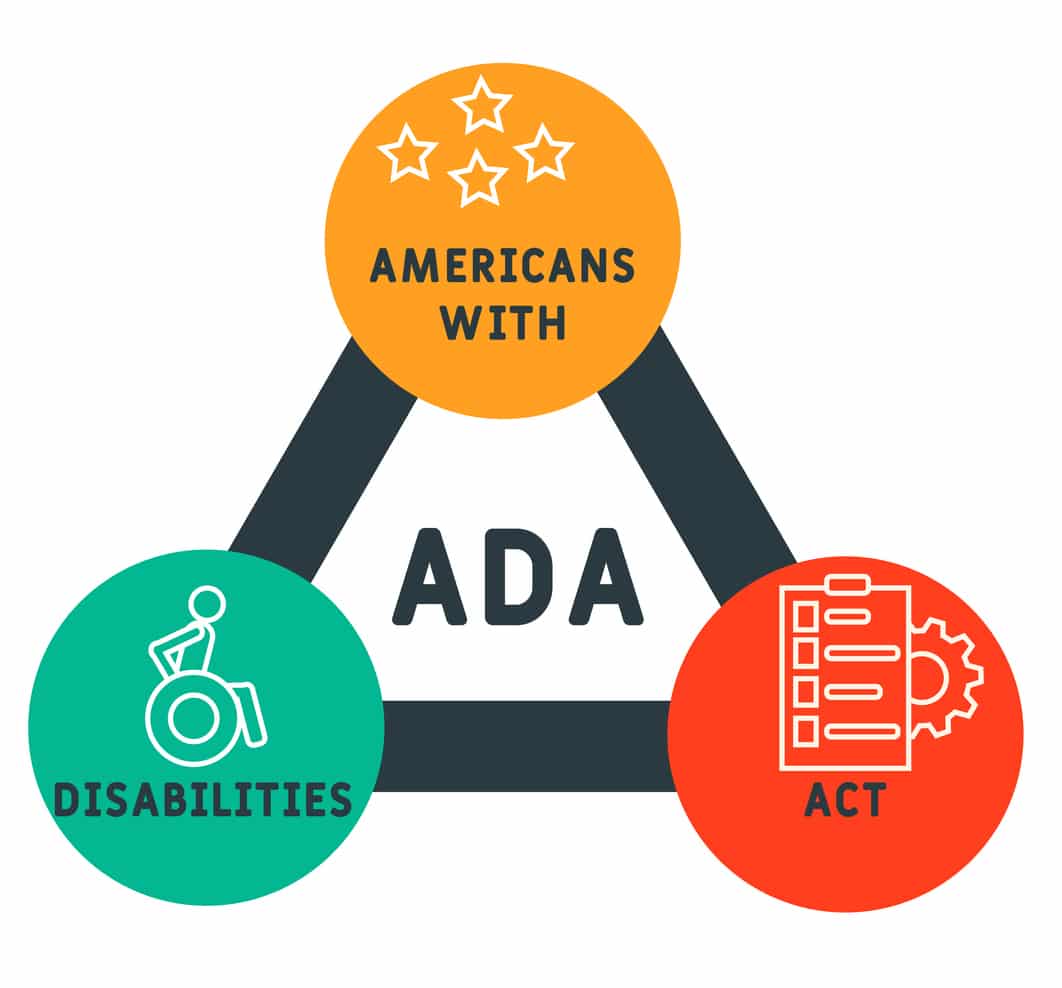Menu
May 13th, 2024
Key Takeaways:
- Law firm websites are “service establishments” that must be accessible to all users under the Americans with Disabilities Act
- Web Content Accessibility Guidelines (WCAG) 2.2 Level AA provides the current standard for what is considered adequate accessibility
- The Modern Firm builds accessibility features into every new website from the ground up
The first time The Modern Firm addressed the question of ADA compliance in a blog post was 2017. At that time, attorneys were just starting to ask, “Is my website ADA compliant?” Back then, guidance was still a bit thin on the ground. After all, the Americans with Disabilities Act was enacted in 1990—about a year before the first website went live on the internet.
One of the goals of the ADA was to remove barriers to full participation in society for people with disabilities. You might be wondering, “Is ADA compliance mandatory for websites?” In a word, yes.
These days, “places of public accommodation” means more than just brick-and-mortar buildings to which people need access. Increasingly, and especially since the COVID pandemic, the places we gather, exchange ideas, and do business are online—including law firm websites.
Here is the latest on ADA website accessibility, what your website should be doing to comply (and why) and what The Modern Firm is doing to keep your site on the right side of the law.
What Makes a Website Inaccessible—or Accessible?
Title III of the ADA applies to private businesses, like law firms. And just as you need to make your physical office accessible to people with disabilities, you need to make your website accessible, too. What does that mean, exactly?
Accessibility means different things to different populations. For people with visual impairment, it might mean a website with high color contrast and descriptive “alt text” for images, making it easier for a screen reader to read and describe the website. For individuals with hearing impairment, it’s important to have captions or transcripts for videos and visual alternatives to audible content.
Website visitors with dexterity issues may struggle with clickable elements that are too close together; they might do better with keyboard navigation. Users with cognitive or neurological disabilities may have a hard time using websites with complex layouts, lots of animation, or rapidly-changing content. For them, accessibility might mean straightforward layout and navigation and the ability to control sensory input.
WCAG: A Roadmap to ADA Website Compliance
So, now you have an idea what website accessibility might mean to various users. How do you ensure that you have achieved ADA website compliance? Enter the Web Content Accessibility Guidelines, better known as WCAG.
WCAG is not a law. It’s a set of guidelines established by the Web Accessibility Initiative (WAI) of the World Wide Web Consortium (W3C). If ADA website compliance is your intended destination, you can think of WCAG as the roadmap telling you how to get there.
Like the technology it applies to, WCAG keeps evolving. The current iteration is WCAG 2.2, released in October 2023. As with previous versions, there are three levels of conformance with WCAG 2.2: Level A is the most elementary, and Level AAA is optimal—and very difficult to achieve.
The middle level, Level AA, is what is required by most regulations. In other words, if your law firm website conforms with WCAG 2.2 Level AA, it’s almost certain to be considered ADA-compliant. When developing websites, The Modern Firm works to achieve Level AA conformance—read on to learn more about how we do that.
If you would like an ADA compliance checklist, you can check out the ADA Best Practices Tool Kit for State and Local Governments.
What Happens if My Law Firm Website Isn’t Accessible?
If a law is broken on the internet and nobody notices, does it make a sound? Probably not, but just hoping that your law firm website is ADA-compliant (or that nobody will notice if it’s not) is definitely not the best strategy.
That’s because if someone does try to use your website and finds it inaccessible, they might take legal action, including sending a demand letter or filing a formal complaint alleging that your business is not in compliance with the ADA. The number of ADA website compliance lawsuits rose 42% just between 2022 and 2023.
Great News: Accessibility = Marketability
Avoiding possible litigation is a pretty good reason to have an ADA-compliant law firm website. But there’s an even better one (besides just doing the right thing for your clients): websites that are ADA-compliant rank better on search engines, including Google.
Google is always tweaking its algorithm: sometimes in minor ways, sometimes major, like with the March 2024 Google core update. Google and other search engines are constantly trying to improve user experience. When your website is accessible, it’s relevant to more people, and it’s easier for them to get what they need from it. Let’s talk about some of the practical considerations that involves, and how The Modern Firm helps our clients stay in compliance.
How to Make a Website ADA Compliant (and Better Serve Your Clients)
Website accessibility is like any other service or amenity you want to provide your clients; you consider their needs, and then you try to do what’s best to meet those needs. Most people with disabilities have their own devices configured with their own preferences, whether it’s large font, high contrast, or a screen reader. Accessibility measures should make it easier for those tools to work—not compete with or override them, as some overlay tools do.
Brendan Chard, owner of The Modern Firm, puts it this way: “Our philosophy has always been to make the website as accessible as it can be from the ground up, so that it’s compatible with whatever assistive technology a disabled person might be using, without getting in their way.”
Some of the ways we do that are:
Provide text alternatives for non-text content
How does a visually impaired person navigate a website? Often it's through text-oriented screen readers. Screen readers can't "read" pictures, but a website's HTML can have "alt text" (alternative text) for images that describe the content of the image. So, for instance, when the reader encounters a headshot of an attorney on their biography page, it would tell the user "Photograph of Attorney John Smith" if that "alt text" was programmed into the website code.
Provide captions and other alternatives for multimedia
Closed captions are primarily for people who are deaf or hard of hearing. These captions appear at the bottom of the video screen and are time-synced to the audio on the screen. Closed captions can require a specific machine to decode and show them, or they may be toggled on intentionally on particular video platforms. Thus, they are called "closed" because they're only displayed to a closed group of people. "Open captions" are captions that are baked into the production of the video.
There are automatic captioning services that will likely get you most of the way there for the captions, such as services offered by Rev.com. You can also manually add captions through YouTube, or use the site’s speech recognition technology to add captions.
Finally, a transcription for your videos creates added benefits for many site visitors. Not only can a transcription be sight read, but it can be accessed by any technology that converts text for particular users—e.g. by tech that reads aloud or converts to Braille. Further, while closed captions and audio descriptions must be time-synced to what's happening on the screen, static text like a transcript allows a person to review the information at their own pace. There are various services that can transcribe videos for a reasonable price per minute and guarantee 99% accuracy. Rev.com is a good option, as is TranscribeMe.
An alternative to transcription that generally serves the same purposes—particularly for informational videos like Video FAQs—is including a complementary article on the same topic as the video.
Audio descriptions
Audio descriptions are primarily for people who have visual impairments. They consist of voiceover explanations of what's happening on the screen. These are less often critical for our law firm clients, since most of the video content we use consists of either an attorney or a former client simply speaking to the camera. (When you start working parkour into your video presentations, however, we'd better talk.) Surprisingly, Youtube and Vimeo have only recently added support for full audio descriptions.
A full, moment-to-moment audio description can be distinguished from a very basic description of a video's content, however. Such basic descriptions are still useful for any information that isn't otherwise stated in text and is important to the video's context, such as: who is speaking, where they are, etc. Like: "Former client, Maria Smith, seated in her living room with her pet ferret." Or: "Attorney Jada Jones, standing in her office, wearing a chicken costume." A basic description like this may even simply be added to the alt text for the video.
Ensure adequate color contrast
For users who are colorblind or have other visual impairments, color contrast makes content easier to read and prevents eye strain. The Modern Firm uses a color contrast analyzer tool to ensure that contrast minimums meet WCAG Level AA standards. If a pair of colors put into the tool have adequate contrast with each other, a green check mark appears. Diego Aguierre, TMF’s Creator Director notes, “There are a surprising number of colors that don’t have sufficient contrast with white.” With the color contrast analyzer tool in our toolbelt, we don’t have to guess.
Is Your Website Friendly to All Your Potential Clients?
If your website was designed by The Modern Firm, most of the accessibility recommendations we’ve discussed in this blog post were already built into your site from Day One. Sites built before 2011 may need some work under the hood to bring video accessibility and programming up to speed (and let’s be honest, if your site is that old, it’s past time for a website redesign, anyway).
The requirements for ADA compliance for websites will continue to evolve with the technology. The Modern Firm will remain committed to staying on top of best practices for ensuring access to the web for users of all abilities.
Questions? Existing clients can contact our support team at support@themodernfirm.com with specific inquiries about their law firm websites. If your law firm needs a new website and you’d like to work with a law firm website designer attuned to accessibility issues, contact us!





